World War I delayed or completely thwarted the construction of several large ocean-going passenger ships planned or under construction across Europe. Work on the giant steamer under construction for Austro-Americana, one of Austria-Hungary's largest transatlantic shipping companies, was also suspended. The ship built in the Monfalcone Shipyard near Trieste, eventually became one of the "victims" of the unfolding military operations as the front line oscilled for several times through the shipyard. What kind of ship would it have been? What justified fot the Dual Monarchy the building a passenger ship of a hitherto unknown size in the country, and what caused its doom? This study answers these questions.
I.) Background - Birth of Austro-Americana:
The favorite of Austrian (Austro-Hungarian between 1867-1918) shipping was the Austrian Lloyd (Österreichischen Lloyd) shipping company, founded in 1833. At the outbreak of the First World War in 1914, it had a total of 65 ships with 235,000 GRT and more than 6,000 employees, so it was the largest merchant shipping company in the country. For a long time, it had no rivals in the Austro-Hungarian Empire on the northern shores of the Adriatic (the northernmost arm of the Mediterranean Sea).
The seafarers of the empire, for the most part, carried only local and Mediterranean sailing, also typically with sailing ships. However, members of the Cosulich family in Lussipiccolo (today: Mali Losinj, Croatia) - Antonio Felice Cosulich and his sons Castillo and Alberto - recognized that the future is belonged to the steam shipping, and in 1895 was set up the Cosulich Shiping Line (Cosulich Società Triestina di Navigazione) in the main Austrian port of Trieste, which city was then under the jurisdiction of Austria-Hungary.
In the same year, 1895, Austrian hauler Gottfried August Schenker and Scottish shipping merchant William Burell to establish the freight line of Austrian-American Shiping Co. (or Compagnia di Navigazione Austro-Americana) between Austria and North America, initially with an eye on supplying the Austrian textile and cotton industry, with the aim of decoupling the supply of Austrian industry from expensive German and unreliable Italian ports. The company was also headquartered in Trieste.
Taking advantage of the economic crisis of 1901-1902, the Cosulich brothers acquired all shares of William Burell when he left the company and they became co-owners of the Austro-Americana in 1902, which henceforth had been known as Schenker, Cosulich und Co., Austro-Americana. At the same time, Alberto Cosulich set up a shipyard in Monfalcone (that was the Cantiere Navale Triestino - CNT) near Trieste. One year later, the Cosulich brothers also contributed their existing 14 cargo steamships to the joint venture, which was renamed as "Vereinigte österreichische Schiffahrtsgesellschaften der Austro-Americana und der Gebrüder Cosulich" (Italian: Unione Austriaca di navigation e Fratel-li Cosulich Societá anonima), so that the name Schenker was omitted from the company name. The company's 19 cargo ships sailed on the Trieste-Messina-Naples-Palermo-New York route, and in 1904 the company became involved in transatlantic passenger transport as well.
Transatlantic emigration from the Austro-Hungarian Monarchy was for a long time in the hands of the German Norddeutscher Lloyd and the Hamburg America Line, but in 1902 the British Cunard Line agreed with the Hungarian government to expatriate Hungarian emigrants through the Hungarian port of Fiume (today Rijeka, Croatia), and the concession was extended in 1903 to Austrian subjects too. Some part of Cunard's profits "flowed back" to the Hungarian shipping companies, so in return they voluntarily gave up the competition. (The most well-known Cunard ship depart from Fiume, was the CARPATHIA steamer, rescuing the survivors of the TITANIC).

Fig. 1: Routes of the Austrian and Hungarian merchant shipping companies 1833-1918. Austro-Americana sailed primarily to the North and South American continents, the Austrian Lloyd to Africa and the Middle and Far East, and the Hungarian shipping companies typically sailed to the Black, Aegean and Mediterranean ports (created by : Dr. Tamás Balogh).
However, Austro-Americana, founded by the Cosulich brothers in Trieste, reacted differently when it decided not to hand over the entire emigration business to the English. On June 9, 1904, the company's steamer GERTY set sail for New York, with 314 emigrants on board. The German companies endorsed the Austrian ‘standstill’ (if their own ships had already dropped out of this race) and opened the ‘Atlantic Pool’, a price cartel of shipping companies transporting emigrants to the line, which had it's own effect: the Austro-Americana's freight and passenger traffic soared.
Voyages to New Orleans and South America began in 1907 (the New Orleans route was discontinued in 1908), and an agreement was reached with Canadian Pacific in 1913 to provide alternative routes from Trieste to Canada, but this was ultimately not found economical and after 6 trips (still in 1913) it was decided to stop continuing the service. In 1904, the company's ships carried only 4,224 people and 2,172 tons of cargo, but by 1912, there were already 101,670 passengers and 10,133 tons of cargo (that is, during only 8 years, the number of passengers increased in twenty-four times, and freight-traffic quadrupled). The company's fleet numbered 28 units in 1914, handling almost 17% of all maritime freight to Austria-Hungary (95% of goods from South America).
This, of course, required new, modern, large passenger ships and, of course, additional capital, provided in part by Austrian government subsidies (1.53 million Kronen in 1903) much less than in the case of the Austrian Lloyd's of 10 million Kronen in the same year. As a result, as early as 1911, a profit of 1.5 million Kronen was distributed among the shareholders. It is no coincidence that this company built the largest Austro-Hungarian transatlantic ocean liners. The 5,491-tonne SOFIE HOHENBERG, named after the consort of the Austro-Hungarian heir to the throne, was built in Trieste in 1905. The 8,312-tonne MARTHA WASHINGTON, named after the wife of the first American president, was built in Glasgow in 1908. The 12,568-tonne KAISER FRANZ JOSEF I, named after the emperor and king of the Dual Monarchy was built in Trieste in 1911 as the largest (launched) steamer in Austro-Americana fleet and the largest merchant ship of the Country.
Following the success of Austro-Americana, in 1912 the company's shipyard in Monfalcone began building an even larger ship, the KAISERIN ELISABETH, which, however, could never be completed due the outbreak of World War I. Yet, if built, this ocean liner would have been the largest Austro-Hungarian ship ever built…
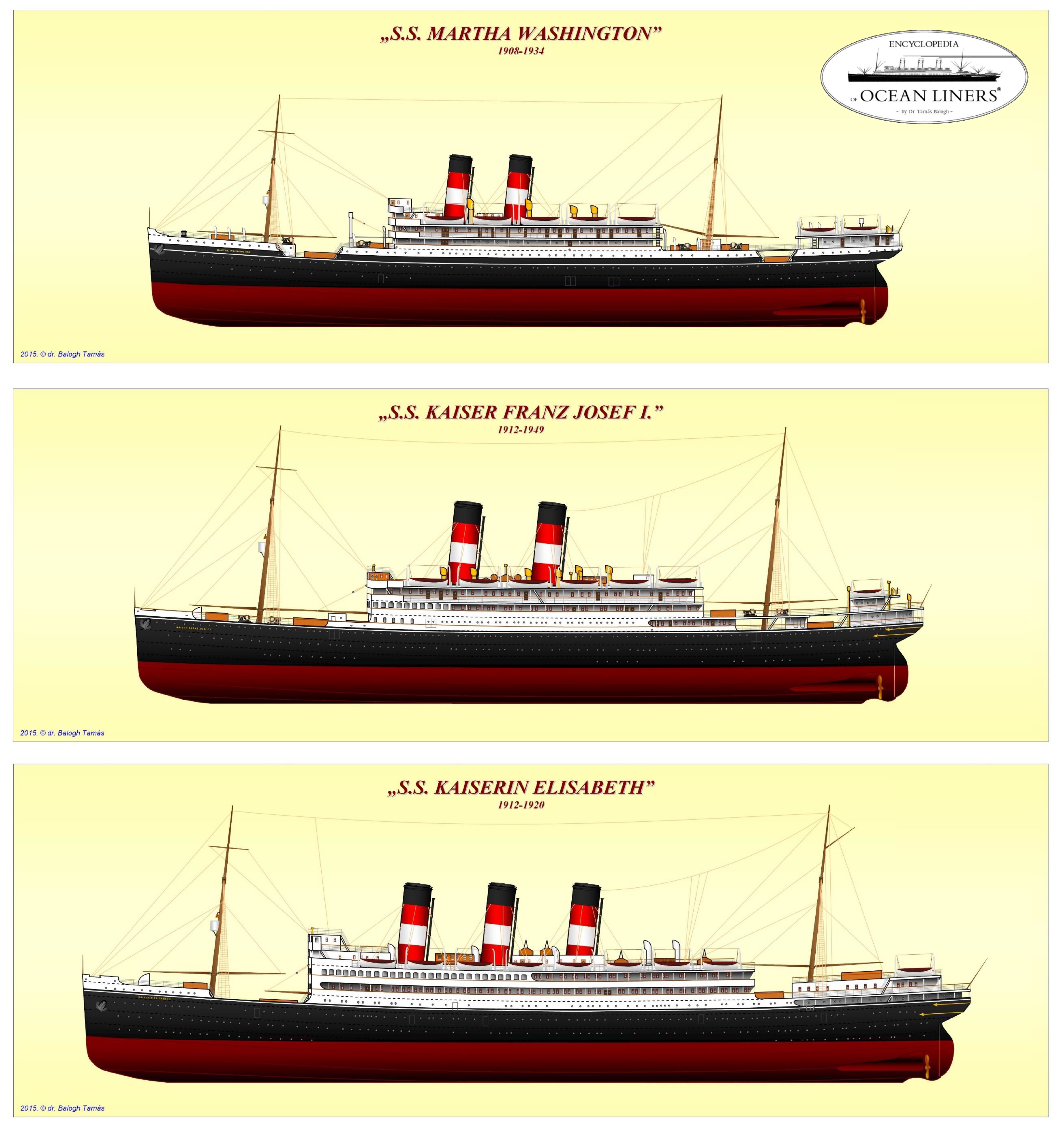
Fig. 2: Liner-series of the Austro-Americana: Profile drawings of the, MARTHA WASHINGTON (above) which was built as a model at Russel & Co. Shipyard in Glasgow; the KAISER FRANZ JOSEF I. (in the middle) which was built on the basis of the plans of the previous, but as a result of own design of the Monfalcone-shipyard; and finally the KAISERIN ELISABETH, of which the first attempt to reconstruct it's profile drawing made in 2015 (created by Dr. Tamás Balogh).
I.) Construction and demolition of KAISERIN ELISABETH:
Construction works of the largest Austro-Hungarian liner, the KAISER FRANZ JOSEF I. not finished, when the owner shipping company and the builder (Monfalcone shipyard near Trieste) begun preliminary studies and preparation of plans for the second unit, the bigger and faster KAISERIN ELISABETH. The new ship designed to the North-Atlantic route for the service between Europe and North America.
KAISERIN ELISABETH's plans are based on the company's latest ships, MARTHA WASHINGTON and KAISER FRANZ JOSEF I.


Fig. 3 and 4: The birthplace of Austro-Americana ships in the Cantiere Navale Triestino Monfalcone. In the south-eastern part of the shipyard, 7 and in the north-western part (in the newly built-up part), there were 3 additional slipways for the construction of ships of different sizes. The largest ships were built on the longest and widest slipways (No. 2 and 3). The picture below shows a terrain table made from the shipyard in 1914, on the left of which is a model of the KAISERIN ELISABETH, lifted into the floating dock (source: Consorzio Culturale Monfalconese, Museo del Mare, Trieste).
Length (waterline): 164,59 m
length (owerall): 175,0 m
Beam: 20,65 m
Draught: 13,18 m
Displacement: 14 700 GRT
Speed: 19,5 knots (36,1 km / h)
Capacity: 2 000 passenger
Propulsion: 2 shafts, 2 × triple expansion engines
When the first months of operation of the newly overhanded KAISER FRANZ JOSEF I. definitely provided a positive experience, the company's management speed up the construction of the new vessel.
The chronology of the construction process and the forced shutdown caused by the war, followed by the demolition of the almost complete hull after the war, is as follows:
November 30, 1912. Laid down in Monfalcone Shipyard (yard number is No. 39). Some authors wrote that the first big transatlantic liner built in this yard was the CONTE GRANDE of 1927, but the truth is: the KAISERIN ELISABETH was first big liner built there.
October 14, 1914.: A construction worker injured in advanced stages of construction. Due to the outbreak of war the construction is suspended. At that time, the plant would continue production at the DDSG shipyard in Budapest (the Óbuda shipyard) and the Azrenál in Pola (mostly to fulfill military orders, including the production of U-27 submarines for the fleet).
May 1915: After the Italian declaration of war the Austro-Hungarian and Italian front line has passed through many times of Monfalcone shipyard, where the unfinished hull standing. The ship has been damaged several times (due to more artillery hit a fire broke out in the interior).
July 1915: The Italian offensive launched on the Isonzo Front on June 23, 1915 - due to deficiencies in proper preparation and complete disregard for terrain - stalled in early July, and the Monarchy Army launched a large-scale counterattack on July 18. One of the “victims” of the military operations was KASIERIN ELISABETH in the shipyard that situated exactly on the front line. The shipyard was brought under Italian military control on 9 June with the first Italian attack. In response to the Italian attack that stalled on July 7, artillery preparations for the Austro-Hungarian counterattack will begin the next day, July 8, during of which the entire shipyard and the ocean liner on the slipway damaged severly. The 15,000-tonne giant, which is in the advanced stages of construction, is hit by several Italian incendiary grenades up to the height of the lower deck of the middle superstructure, which causes catastrophic fires inside the hull, which are further damaged by the subsequent bombing of Italian artillery.
October 1915: Artillery bombardment of the Austro-Hungarian army advancing in the direction of Monfalcone, damages again the hull burnt out by fire, which is virtually impossible to extinguish between the two fronts on no-man's land.
October 1917: After the breakthrough in Caporetto (the collapse of the Italian front on October 24, 1917), Austro-Hungarian troops recaptured the shipyard and docks. The Cosulich family turns to the imperial and royal governments for compensation to recover the shipyard from the damages caused by the military operations and to restart production. It is presumed, that for a period of time (until a full damage assessment has been made) the owners were planned repair the damage to the ship and continue construction work. They changed the name of the ship to ISONZO (after the location of those victorious battles which made possible to take back the shipyard). However, a thorough analysis reveals that there is nothing to recover on the ship, as the giant in the line of fire has been so badly damaged by successive artillery attacks that it is impossible to repair.
November 1918: Although the Padua armistice (November 3, 1918) said the territory of the Monfalcone shipyard remained with the Monarchy, the loss of the war (and the disintegration of the Austro-Hungarian Monarchy as a consequence of it) completely thwarted the utilization of the huge ship. The parts of it completed so far will therefore be demolished after the Italian occupation of Triest.
October 1920: Removal of the last structural elements of the semi-finished vessel.

Fig. 5: Hulls of two ocean liners constructed on the commission by Austro-Americana, photographed on June 9, 1915, by Italian war correspondents arriving at the shipyard from the northwest. The ship on the starboard is KAISERIN ELISABETH.

Fig. 6: A close-up view from the stern of the ship clearly showing the rudder and one of the propellers, as well as the stern superstructure and the open promenade, below that. The fully opened lower promenade (guarded with a steel parapet) of the midship superstructure can be seen forward. Above it is the upper promenade which guarded with steel parapet on it's forward part only (on the left side of the picture). (Source: Atlante / Dizionario del 1915 in Friuli Venezia Giulia)
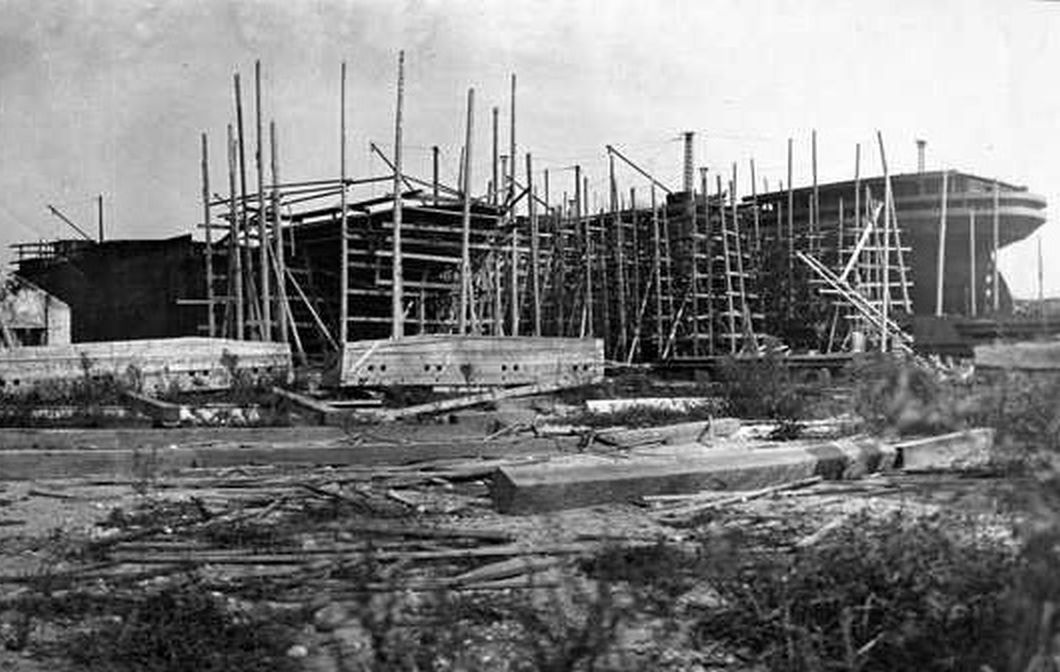
Fig. 7: Ocean liners, abandoned incomplete forcilby, and all the perforated side plates (in the foreground) stacked for the construction supported on top of each other. (Source: Associazione Marinara Aldebaran, Trieste)
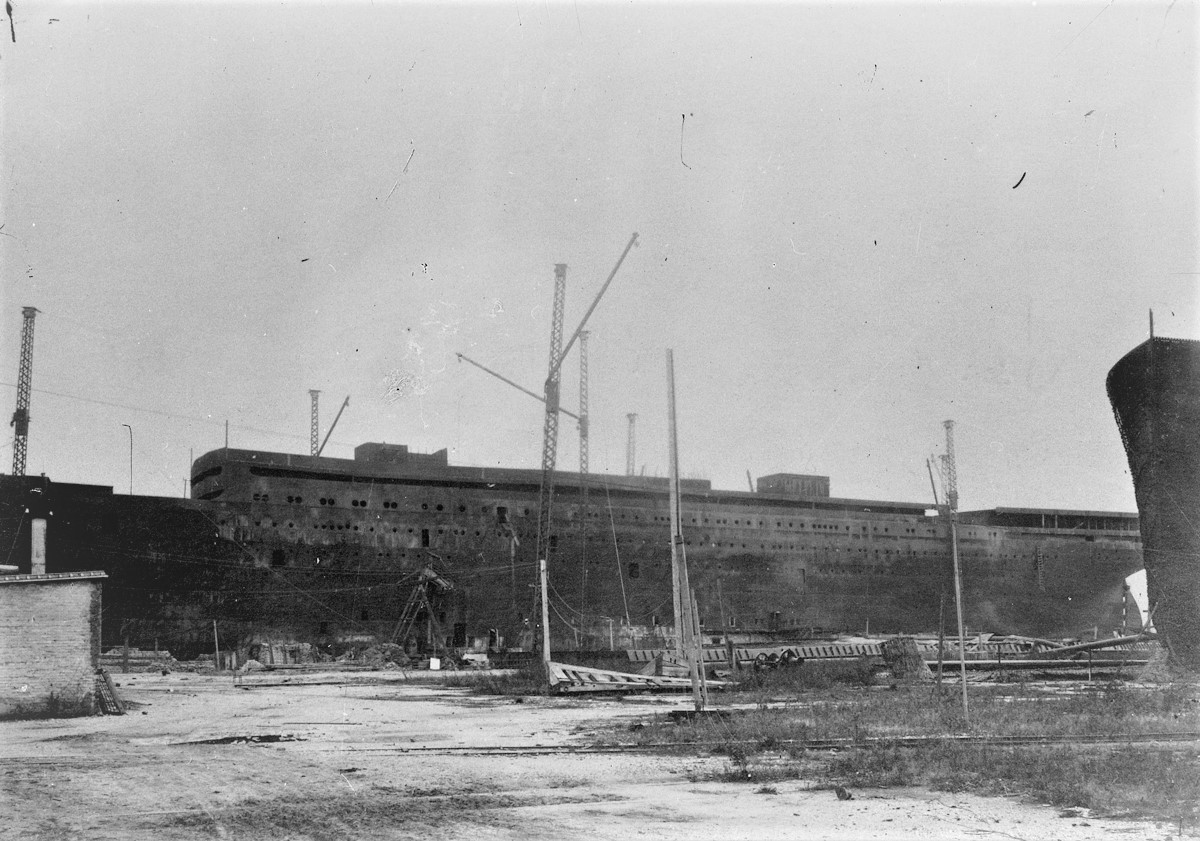
Fig. 8: Left side of KAISERIN ELISABETH facing the Italian positions at the start of the attack. The middle superstructure and its two promenade decks can be clearly visible: the lower (guarded with steel parapet in full length) and the upper (guarded with steel parapet only in it's fore end). The smoke stacks of the first funnel is visible on the upper promenade deck and the rectangular structure of the engine shaft is visible in the rear.

Fig. 9: Smoke rises from the hull, soot and burn marks above some openings. The “Italian side” of the ship damaged in the artillery attack in June 1915. The promenade decks of the middle superstructure are clearly visible: the lower guarded with parapet in it's full-length and the upper which guarded by parapet only in the first half. (Source: Associazione Marinara Aldebaran, Trieste)

Fig. 10: Starboard side of the ship from the Austro-Hungarian forces. Trace of a direct artillery hit at the front, just below the upper row of windows in the bow. Signs of strong burns everywhere on the discolored hull. (Source: Wikimedia Commons).

Figs. 11, 12 and 13: Object No. 39 on the slipway in 1919. In the middle picture, Italian soldiers are talking in the foreground. Next to the ocean liner (in the mesh of the wooden scaffolding), a cruiser originally built for China and then seized for the Austro-Hungarian Navy at the outbreak of the war, which also remained unfinished due to the transit of the front. (Source: Associazione Marinara Aldebaran, Trieste)

Fig. 14: During clearing the ruins on the shipyard site, the above picture was taken in the early 1920s, when the ocean liner built originally on the slipway next to the KAISERIN ELISABETH had already been dismantled and a new large slipway was built in place (and reinforced concrete pillars of it, holding the crane track, were shuttered). There are plenty openings in the hull below the waterline which were cut in order to the demolition workers can enter the ship. The two decks of the middle superstructure, the aft superstructure and the parapets of the forward well-deck have already been clearly demolished. This is the last known picture of the ship. (Source: Associazione Marinara Aldebaran, Trieste)
III.) Reconstruction of the ship:
To the best of our knowledge, the ship's plans have not survived. In addition to the main dimensions, what is known about the appearance and general arrangement of the ship is based on just a few sources:
1) Several photographs have survived of the hull under construction or damaged due to the transit of the front (Figures 5-14), which are preserved in Italian archives.
2) The ship appears on the large panel of the famous Austrian naval painter Alex Kircher (1867-1939) depicting the port of Trieste, which is now on display at the Technisches Museum in Vienna (Fig. 15-16).
3) In addition, there is a terrain table made in the port in 1914 (Fig. 4), the creators also made a small-scale model of the ship (Figs. 17-19). The terrain table is preserved in the Museo del Mare of Trieste.


Figs. 15 and 16: Alexander Kircher's "Triester Hafen" ("The Port of Trieste"). a painting from 1918 (below on the previous page) and a detail of it depicting the ship (above).
Together, these sources have made it possible to reconstruct the ship’s main features, which we are now happy to share with those interested. Reconstruction was hampered by the fact that the three sources (the contemporary painting, the photographs, and the model on the contemporary terrain table) depict certain details differently. Of these, the photographs were accepted as authentic, the small-scale model and the painting of the period, used only where there is no doubt about the authenticity of the details on them.
In view of the above, about the general arrangement of the ship can be said with great certainty: the 175-meter-long ship would have been a three-funnelled, two-masted, twin screw vessel, with three harmoniously arranged superstructures (forecastle, amidship island and raised poop deck); with a conventional triple-expansion steam engine.
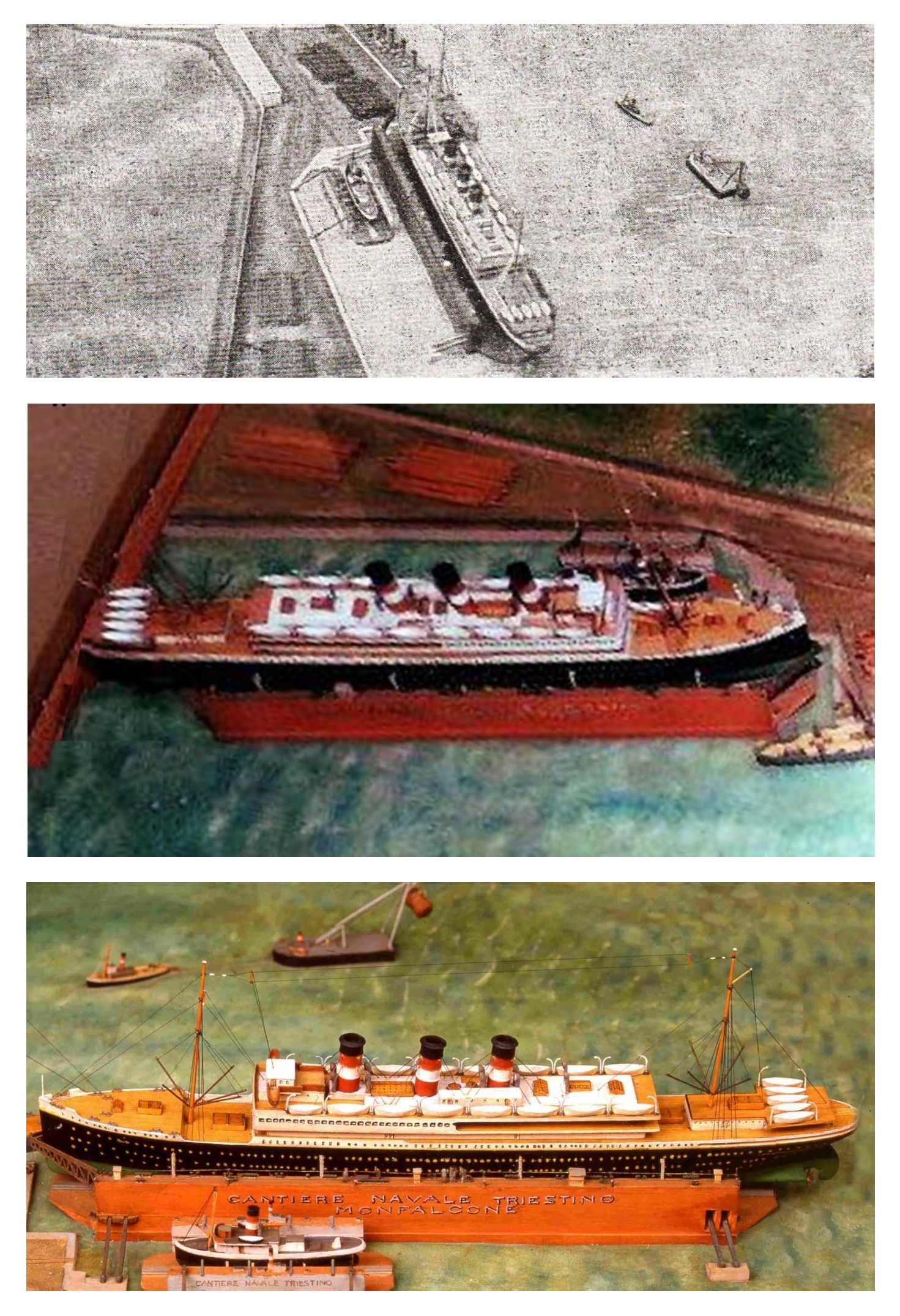
Figs. 17, 18 and 19: Terrain table at the Cantiere Navale Triestino shipyard in Monfalcone with a model of the ship. (Source: Wikipedia, Pinterest).
The contemporary depictions contained the most differentions in the design of the promenades of the superstructures and the navigation bridge.
1) The model on the terrain table of the shipyard (which is so small that not even the access doors on the side of the hull have been worked out) shows two promenade decks on the amidship superstructure, the lower one opened at its full length and the one above is glazed at the front end and equipped with an open promenade in the back. There is a parapet at the front of the two promenade decks and only handrails at the rear protect the passengers (but the plate parapet on the upper proemnade deck is longer).
The forecastle is separated from the amidship superstructure by a forward well-deck. On this is the foremast and one of the cargo hatches of the forward cargo spaces (the pair of which is located in front of the foremast on the forecastle).
According to the model, two promenade decks have also been built in the aft part of the ship: an open proemande into the hull protected by a parapet (which runs around the rounded stern of the hull above the stern post of the counter stern) and an open promenade above the previous one as short section on each side of the stern superstructure (the top of this promenades is a platform for launching lifeboats on the superstructure).
Hatches leading to the aft cargo spaces were located in the open deck section separating the raised poop deck from the amidships island. The main mast stands in the middle of the first half of the stern superstructure.
The bridge was standing at the front end of the boat deck (which formed the uppermost level of the amidship superstructure), on the roof of the deckhouse, which housed the officers, suites drawn backwards from the front parapet, and pulled considerably backwards from its front wall. The wings of the bridge were open in its entire length.
2) In the Kircher painting, on the other hand, the front of both promenades of the middle superstructure is glass-enclosed (the lower is longer) and protected along its entire length by a plated parapet.
On each side of the forward well-deck separating the forecastle from the amidship superstructure was a deckhouse connected to the parapets with a lifeboat at the top.
Raised poop deck is not visible. In the painting, only a deck house similar to that one is on the forward well-deck appears, with a lifeboat on top. The hull lacks an opened promenade around the rounded stern on the top of the stern post.
At the front end of the boat deck (the width of the officers' quater, between it's front wall and the forward parapet of the boat deck) is a glass-enclosed corridor through which passengers can pass between the two sides of the boat deck. It also serves as a windscreened lookout point for them on the ocean.
The vertical plane of the front wall of the wheelhouse in the center of the navigating bridge is the same as the plane of the forward parapet of the boat deck.
At the end of the two wings of the bridge are a wing caps (navigation cabins).
3) The photographs show a different genaral arrangement at several points from that, what described above. It is true that the amidship superstructure has two promenade deck above each other, but the lower promenade (which is open to its full length) is protected by a plated parapet. Handrails can only be found on the aft (opened) part of the upper promenade (there is a plated parapet only on the forward part, where the upper promenade is glass-enclosed).
The bridge and the wheelhouse had not yet been built at the time of the photographs were made, but on the basis of the parapet on the forward end of the upper deck of the amidship superstructure (the boat deck) it is probable that the solution shown in the model of the shipyard terrain table was used (instead of the solution shown in the Kircher painting).

Figs. 20, 21 and 22: General arrangement as seen from the Kircher painting (above), the model (middle) and the photographs (below) (created by Dr. Tamás Balogh).

Fig. 23: Revised reconstruction of the ship based on the new-found photographs (created by Dr. Tamás Balogh).
Epilogue:
KAISERIN ELISABETH was the largest ocean liner to be built in the Mediterranean basin at the time of its keel laying in 1912. However, its priority would not have lasted long, even if World War I had not broken out and the ship's construction would be completed and it would begin its scheduled voyages. The three GALLIA-class French ocean liners (GALLIA, LUTETIA and MASSILIA), which were in service during 1913-1914, were slightly larger in size (with 182 m in length and 14,966 tonnes in displacement), and two new italian liners began construction in 1916, the DUILIO and the GIULIO CESARE - although these ships were not completed until after the war (just in 1923 and 1926) - were considerably bigger (with 194 m in length and 25,000 tonnes in displacement).
Nevertheless the most special rival for the largest merchant ship in the Austro-Hungarian Monarchy did not come from France or Italy, but from Germany, when the German shipping company HAPAG, which operated profitable North Atlantic shipping services, ordered two new ocean liners, for its Italian affiliate company Transatlantica Italiana Societa Anonima di Navigazione, which was aquisitioned in 1913. (this line was founded in 1897 under the name Ligure Brasiliana): one liner for the North Atlantic traffic and one for the South Atlantic routes to sail from Italian ports and under the Italian flag. The North Atlantic steamer and its sisiter ship, the CONTE di CAVOUR, to be built under the name ANDREA DORIA, would have been 237 m long and 37,000 tonnes in displacement, while their smaller counterpart for the South Atlantic would have been built exactly in the same size cathegory as the KAISERIN ELISABETH, with 175,4 m long and 18,500 tons in displacement.
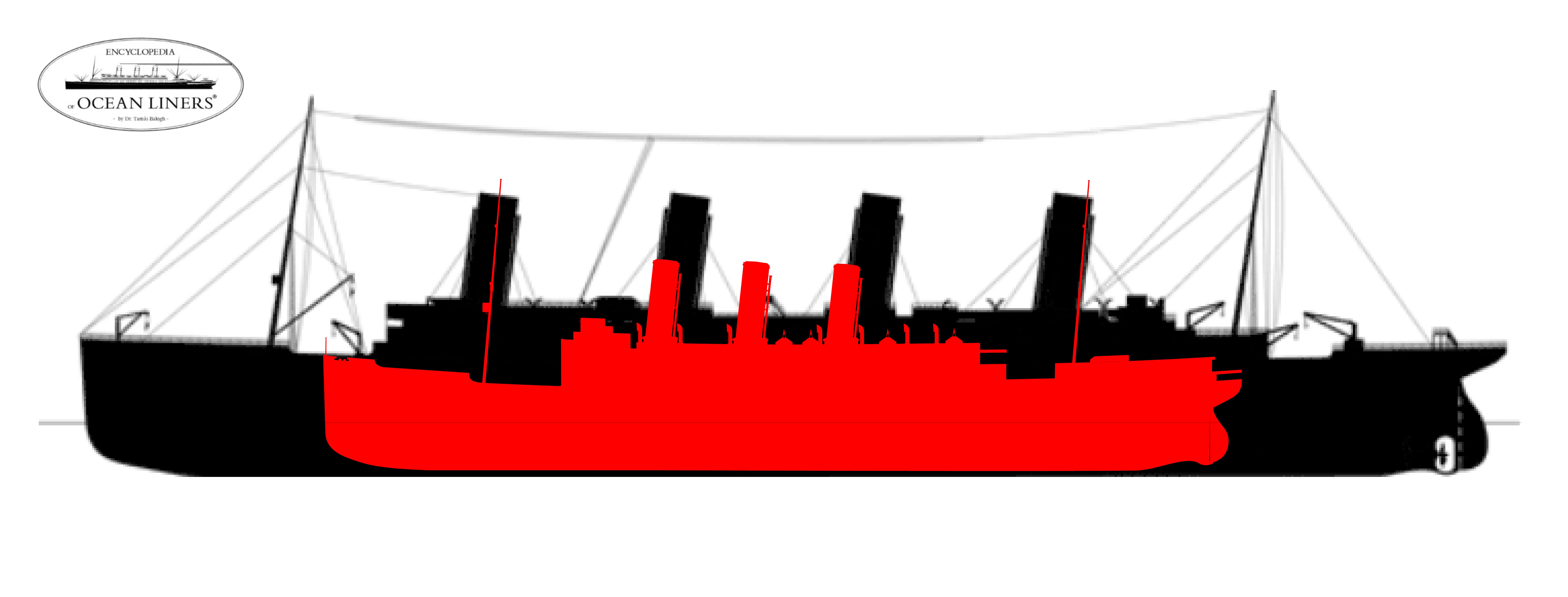

Fig. 24: Comparison of KAISERIN ELISABETH and TITANIC (above). The upper size category of the Mediterranean ocean liners of the 1910s evoked the size of the largest Atlantic ocean liners of the 1890s. The size of the KAISERIN ELISABETH was around as the length of the CITY OF ROME built in 1881 (171 m), and as the displacement of the CAMPANIA launched in 1895 (13 000 tonnes) (created by Dr. Tamás Balogh).
Fig. 25: General arrangement of KAISERIN ELISABETH (below) (created by Dr. Tamás Balogh).

Fig. 26: KAISERIN ELISABETH and its French and Italian rivals (created by Dr. Tamás Balogh).
However, the construction of these ships also failed: after Italy entered the First World War against its former allies, Germany and Austria-Hungary, in 1915, an Italian board of directors was formed and all German-owned shares in the company were bought, and a year later have given control of the Ansaldo group. The company was liquidated in 1934. The planned large ships were never built. After the war, the Cosulich brothers also restructured their businesses. Austro-Americana continued to operate in the name of the brothers in Trieste, now under Italian rule, as the Cosulich Line until 1937, when it merged into the new, unified Italian national shipping company and continued to operate under the Italia Societa Anonima di Navigazione. The first major post-war ocean liners of the Cosulich Line were built in Monfalcone under the names SATURNIA and VULCANIA in 1925 and 1926 (ships were 200 m long and had a capacity of 24,000 tons).

Fig. 27: Planned German rivals of KAISERIN ELISABETH (created by Dr. Tamás Balogh).
Sources:
To the ocean liners of the Austro-Hungarian Monarchy (only in Hungarian):
To the shown photographic images:
To the ship’s story:
http://www.archeologiaindustriale.it/sez_produzione_it...
Other sources:
https://www.facebook.com/piccolomuseotrieste/photos/a.613516462153412/1068713976633656
http://www.atlantegrandeguerra.it/portfolio/monfalcone/
http://www.atlantegrandeguerra.it/wp-content/uploads/2016/05/4a-MonfalconeCCM-1.jpg
https://journals.openedition.org/diacronie/2594
https://it.wikipedia.org/wiki/Cantiere_Navale_Triestino
https://www.wrecksite.eu/imgBrowser.aspx?11388
https://www.wikiwand.com/it/Cantiere_Navale_Triestino
https://en.wikipedia.org/wiki/Number_64-class_cruiser
https://www.facebook.com/page/167321909959726/search/?q=Kaiserin%20Elisabeth
https://www.theshipslist.com/ships/lines/cosulich.shtml
https://www.theshipslist.com/ships/lines/transitaliana.shtml
https://earlofcruise.blogspot.com/2017/07/history-austro-americana-austro-hungary.html
https://earlofcruise.blogspot.com/2017/07/history-one-of-earliest-steam-ship.html
https://earlofcruise.blogspot.com/2017/07/history-one-of-earliest-steam-ship_30.html
https://www.austrianinformation.org/current-issue-summerfall-2013/austro-americana
It would be great if you like the article and pictures shared. If you are interested in the works of the author, you can find more information about the author and his work on the Encyclopedia of Ocean Liners Fb-page.
If you would like to share the pictures, please do so by always mentioning the artist's name in a credit in your posts. Thank You!

Utolsó kommentek